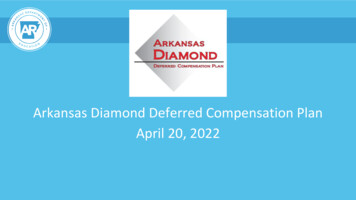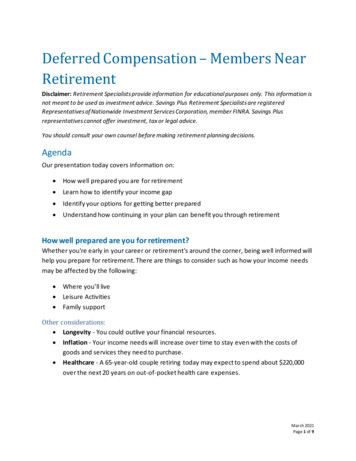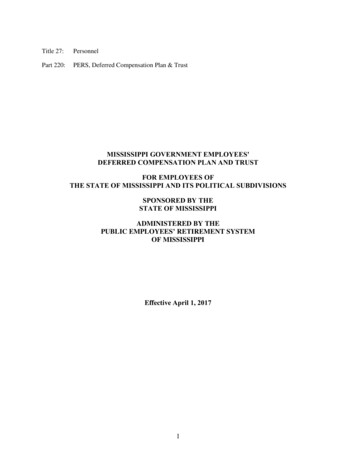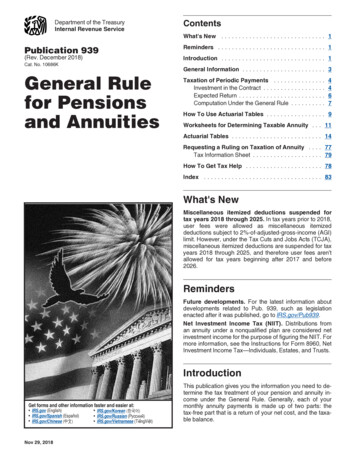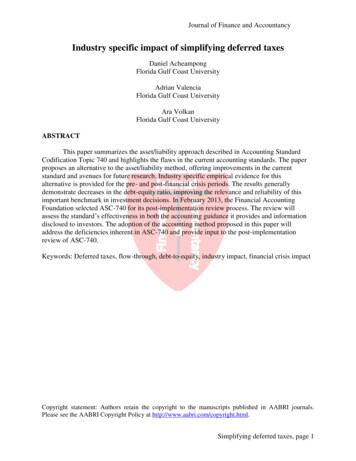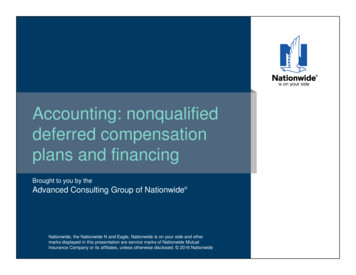
Transcription
Accounting: nonqualifieddeferred compensationplans and financingBrought to you by theAdvanced Consulting Group of Nationwide Nationwide, the Nationwide N and Eagle, Nationwide is on your side and othermarks displayed in this presentation are service marks of Nationwide MutualInsurance Company or its affiliates, unless otherwise disclosed. 2016 Nationwide
Some things you need to knowThis presentation is for educational purposes only and is not intended to be a solicitation orsale of a specific product or service.The general information in this presentation is not intended to be nor should be treated astax, legal, accounting or other professional advice. Additional facts and circumstances mayexist that would impact the tax treatment of a specific transaction. Taxpayers should seekadvice from an independent tax advisor before acting on any information presented.Federal tax laws are complex and subject to change. The information contained herein is notintended to be, and should not be construed to be, tax or legal advice. Neither Nationwidenor its representatives give legal or tax advice. Consult with your attorney or tax advisor foranswers to specific questions.The Nationwide Group Retirement Series includes unregistered group fixed and variableannuities and trust programs. The unregistered group fixed and variable annuities are issuedby Nationwide Life Insurance Company. Trust programs and trust services are offered byNationwide Trust Company, FSB a division of Nationwide Bank . Nationwide InvestmentServices Corporation, member FINRA.NFM-15214AO (04/16)2APPROVED FOR USE WITH THE PUBLIC2
Agenda Introduction Financial statements– Balance sheet– Income statement Sample journal entries– Defined contribution plan accounting– Defined benefit plan accounting– Deferred tax asset– When benefits are paid Financing methods– Corporate-owned life insurance (COLI)– Corporate-owned taxable investments33
IntroductionThis presentation will cover sample accounting entries fornonqualified deferred compensation (NQDC) plans, corporateowned life insurance (COLI) and corporate-owned taxableinvestments that are purchased to informally fund a NQDCplan.Please consult with your accounting or tax advisor for advicethat is specific to your situation.44
Financial statements Qualified plans No effect on employer’s balance sheet Contributions to the plan are an expense Nonqualified deferred compensation plans Assets (COLI / taxable asset) and plan liabilities shownseparately on employer’s balance sheet Increases / decreases in asset and plan liability values arereflected on employer’s income statement and balance sheet 5Gains/losses of investmentsAdditional amounts credited and contributedDistributions and withdrawalsDeath benefits if COLI is used5
Balance sheet The NQDC plan Employees defer 100,000; the employer’s tax bracket is 40%;and the plan’s rate of return is 8% An employee terminates and is paid his account balance of 5,500 in the same yearNQDC plan liability accountBeginning of year balanceDeferred amountsEarningsDistributionsPlan liability account6 0 100,000 8,000( 5,500) 102,5006
Balance sheet NQDC planDeferred tax asset*Opening balance 0Decrease due to distribution( 2,200)Increase due to increase in liability 43,200Ending balance 41,000*The Cash Account would decrease due to taxes paid on amounts deferred77
Balance sheet COLIExample: Employees defer 100,000 and employer uses that to paya premium; the employer’s tax bracket is 40%; and the net rate ofreturn in the COLI is 5%COLI asset accountBeginning of year CSV8 0Increase in CSV (premium earnings) 105,000COLI balance 105,0008
Balance sheet SummaryNet effect on balance sheetNQDC plan liabilityCOLINet effect of NQDC plan and COLI9( 108,000) 105,000( 3,000)9
Income statement (P&L) The NQDC planExample: Employees defer 100,000; the employer’s taxbracket is 40%; and the rate of return in the plan is 8%Pre-taxBenefit / compensation expenseEnd-of-year deferred compensation expenseNet impact on current earnings10 100,000( 108,000)( 8,000)10
Income statement (P&L) Corporate-owned life insurance (COLI)Example: Employees defer 100,000 and employer uses thatto pay a premium; the employer’s tax bracket is 40%; and the netrate of return in the COLI is 5%Pre-taxCOLI premiumEnd-of-year CSV increaseGain / (loss) for the period11( 100,000) 105,000 5,00011
Income statement (P&L) SummaryNet effect on income statementNQDC plan impact on earningsCOLI impact on earningsNet effect of NQDC plan and COLI12Pre-tax( 8,000) 5,000( 3,000)12
SAMPLEJOURNAL ENTRIES13
Defined contribution plan accounting When an employee defers compensation to a NQDC plan The employer sets up a benefit liability account and creditsemployee deferrals to it Adjustments to the benefit liability account for gains/losses aremade periodically The same accounting entries are made for any companycontributions to the planDRBenefit/compensation expense (P&L)Benefit liability (balance sheet)14CRXXXX14
Gains and losses in participants’ accounts Periodic gainsDRBenefit/compensation expense (P&L)CRXXBenefit liability (Balance sheet)XX Periodic lossesDRBenefit liability (Balance sheet)Benefit/compensation expense (P&L)15CRXXXX15
Defined benefit plan accounting The annual accrued liability is added to the liability account The annual accrued liability amount is considered a deferral ofcompensation under Code section 409A There usually are no decreases in the benefit liability accountuntil benefit payments beginDRBenefit/compensation expense (P&L)Benefit liability (Balance sheet)16CRXXXX16
Deferred tax asset The employer cannot take a deduction for compensationwhen it is deferred The total amount of benefit payments will be deductible whenpaid to participants To account for the “prepayment” of tax (or the delay in takinga deduction), C corporations will book a deferred tax asset Employers that are pass-through entities (e.g., partnerships, Scorporations and most LLCs) will not account for thisDRDeferred tax asset (Balance sheet)Income tax payable (Balance sheet)17CRXXXX17
When benefits are paid Decrease the benefit liability account and cash Reverse the deferred tax asset entry made when the liabilitywas credited If earnings/losses continue to be credited to the participant’saccount, the employer will also have to continue to accountfor those during the payout phaseDRBenefit liability (Balance sheet)XXCash ( Balance sheet)XXDRIncome tax payable (Balance sheet)Deferred tax asset (Balance sheet)18CRCRXXXX18
FINANCING METHODS19
Corporate-owned life insurance FASB ASC 325-30 (formerly Technical Bulletin No. 85-4)Accounting for Purchases of Life Insurance governs theaccounting of cash value life insurance COLI is often purchased with the employees’ salary/bonusdeferrals that would otherwise have been paid to them incash The difference between premiums paid in a year and theincrease (or decrease) in cash surrender value is a directcharge or credit to the company’s earnings 20Example: On January 1, company Y paid a premium of 100,000. OnDecember 31, the cash surrender value is 107,000. Company Y willhave a credit to earnings of 7,000 for the year20
Corporate-owned life insurance Accounting for premium payments Premium payments are not a deductible expenseDRCOLI expense (P&L)CRXXCash (Balance sheet)XX Accounting for the cash surrender value The cash surrender value (CSV) is an asset of the companyDRCOLI asset – CSV (Balance sheet)CRXXCOLI expense (P&L)*XX*This is the difference between the premiums paid and the CSV2121
Corporate-owned life insurance Accounting for COLI gains and lossesWhen there is a gainCOLI asset – CSV (Balance sheet)CRXXCOLI premium expense (P&L)XXCOLI gain/other income (P&L)XXWhen there is a lossDRCOLI asset – CSV (Balance sheet)XXCOLI loss (P&L)XXCOLI premium expense (P&L)22DRCRXX22
Corporate-owned life insurance Accounting for withdrawals and loans from COLI WithdrawalsDRCash (Balance sheet)CRXXCOLI asset – CSV (Balance sheet)XX LoansDRCash (Balance sheet)COLI loan account (Balance sheet)23CRXXXX23
COLI death benefits When an insured employee dies, the cash surrender value ofthat policy is taken off the company’s books Usually, the net amount at risk is a gain to the company The total death benefit will be income-tax free*DRCash (Balance sheet)CRXXCOLI asset – CSV (Balance sheet)XXGain/loss on death (P&L)XX*Provided the requirements of Code Sec. 101(j) are met (disclosure andconsent).2424
Corporate-owned taxable investments Governed by ASC 320-10 (Formerly FASB Statement 115) Available for sale securities are accounted for at fair value(“mark to market”) Accounting for the purchase of taxable investmentsDRTaxable asset (Balance sheet)Cash (Balance sheet)25CRXXXX25
Corporate-owned taxable investments Accounting for realized gains/losses Dividends and capital gains distributions that are reinvestedWhen there is a gainTaxable asset (Balance sheet)DRCRXXOther income (P&L)XX Realized gains are taxable to the companyDRTax expense (P&L)Cash (Balance sheet)26CRXXXX26
Corporate-owned taxable investments Accounting for unrealized gains/losses These are gains/losses from a change in the value of the assetthat has not been settled yet (a change in the NAV of a mutualfund, for example) Unrealized gains/losses are credited to a special shareholderequity account on the balance sheet, net of taxes, which arecredited to a deferred tax liability account2727
Corporate-owned taxable investments Unrealized gainsDRTaxable asset (Balance sheet)CRXXSpecial income (P&L)XX Deferred taxesDRSpecial income (P&L)Capitalized deferred taxes (Balance sheet)28CRXXXX28
QUESTIONS?29
Here when you need usNational Sales Desk: Nationwide Financial Network :Brokerage General Agents ption 9, extension:677-6500NFM-15214AO (04/16)APPROVED FOR USE WITH THE PUBLIC30
The same accounting entries are made for any company contributions to the plan DR CR Benefit/compensation expense (P&L) XX Benefit liability (balance sheet) XX 14. 15 . that policy is taken off the company's books Usually, the net amount at risk is a gain to the company The total death benefit will be income-tax free*
